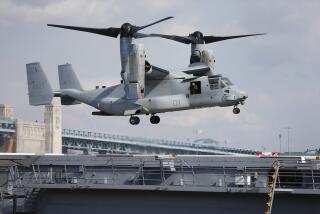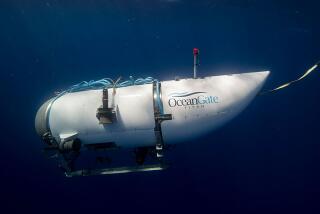Court to Begin Sub Crash Inquiry
PEARL HARBOR, Hawaii — The investigation that begins today into the Greeneville submarine tragedy is called a court of inquiry, and the small room where it will take place could pass for a civilian courtroom.
But there are distinct differences between civilian and military jurisprudence, and therein may lie the tale of what ultimately will happen to Cmdr. Scott Waddle and his officers and crew.
Three admirals will hear sworn testimony about what happened in the minutes before and after the Greeneville, executing an emergency-surfacing procedure as a demonstration for 16 civilian VIPs aboard, smashed into the Japanese fishing trawler Ehime Maru.
Twenty-six people survived the accident, but nine were lost at sea.
The admirals, none of them lawyers, will issue a finding of fact about the Feb. 9 incident and recommend what should happen to Waddle and the others--including the possibility of a court-martial for negligence or dereliction of duty for not spotting the trawler by periscope or sonar.
But the decision on whether to accept, reject or modify the court’s finding and recommendation will be made by Adm. Thomas Fargo, a veteran submariner and now commander in chief of the Pacific Fleet.
The fact that Fargo has convened the court of inquiry, a rarity in the U.S. Navy, does not indicate that he is leaning toward courts-martial or that he has ruled out possible administrative punishment, such as discharge or loss of rank, officials said.
In fact, if Fargo opts against court-martialing Waddle and others responsible for tracking the proximity of ships, the admiral would be squarely within Navy tradition.
It is a tradition of which Fargo, 52, son of a retired Navy captain, is most assuredly aware.
Waddle’s attorney Charles Gittins, who has represented clients in several high-profile military cases, said Sunday that the collision was caused by a “chain of mistakes” in the sub’s control room that left his client unaware of the dangerous proximity of the trawler.
“That doesn’t mean that those people who made those honest mistakes should ultimately be prosecuted for their mistakes,” Gittins said on ABC-TV’s “This Week.”
The phrase “honest mistakes” may loom large in the court of inquiry.
It has been used by the military in the past to explain why no criminal charges were brought in cases involving fatal accidents, including a 1999 crash of a Marine Corps helicopter off San Diego that killed six Marines and a sailor.
In fact, the military has proved itself extremely reluctant to pursue criminal charges in cases of misjudgment or error.
In 1992, the Navy rejected the Turkish government’s demand to court-martial those responsible on the ship Saratoga for firing two missiles into a Turkish destroyer.
A court of inquiry recommended that Cmdr. Lloyd Bucher be court-martialed for not doing more to resist the seizure of his communications ship, the Pueblo, by North Korea in 1968. Its 82 crewmen were held in brutal captivity for 11 months after the seizure. The recommendation was rejected by the secretary of the Navy.
Possibly the most famous court of inquiry examined a 1960 fire in the New York Navy Yard that killed 50 people. It was caused by a cigarette discarded near a fuel line. The court found that the shipyard commander could not be held responsible.
Earlier this year, the chief of naval operations, Adm. Vernon Clark, opted against punishing the captain of the destroyer Cole, which was attacked by terrorists during refueling in Yemen in October. Seventeen sailors were killed.
“Criminal charges are generally for things like falsification of working orders or willful disobedience,” said retired Marine Corps Brig. Gen. John DeBarr, formerly the corps’ top lawyer. “Take collisions at sea. I can’t remember a commander being held to criminal charges, although it’s almost a certainty that his career is over, which I’m sure will be the case here.”
Still, DeBarr said he expects the court of inquiry to be meticulous in attempting to solve the mysteries of the case: Did the presence of the civilians disrupt the crew at a crucial time, why did an enlisted man fail to tell the captain of an approaching boat, and why did Waddle and officer of the deck Lt. j.g. Michael Coen not see the trawler through the periscope?
There is no prosecutor in a court of inquiry. The Navy’s lawyers present the case, but Navy tradition holds that they do not urge that certain action be taken.
Waddle and the others will be present and their lawyers can cross-examine witnesses, which is not allowed in a civilian grand jury.
As in a civilian court, a person under investigation cannot be forced to testify. Waddle’s attorney said his client has not decided whether to testify, submit a written statement or just remain silent; Waddle is seeking assurances that his comments will not be used against him in a court-martial.
In convening a court of inquiry, Fargo said he wanted to signal to the Japanese “the seriousness in which I view this tragic accident.”
The Navy has gone to extraordinary lengths to accommodate the 100 or more Japanese journalists who have come to Pearl Harbor for the court of inquiry.
Fargo’s concern for Japanese public opinion has led to some grumbling in the Navy community that the court of inquiry is a politically tinged “show trial.”
There is, however, a countervailing theory among some retired submariners: that Fargo is “front-loading” by calling a public court of inquiry and expressing condolences to the Japanese because he knows that the chances of criminal charges, as demanded by some family members of those killed, are rare.
On Sunday, some relatives of those killed watched a native Hawaiian group offer traditional prayers and songs during the ocean-side memorial. Family members later sailed to the scene of the accident to scatter flowers across the waters.
More to Read
Sign up for Essential California
The most important California stories and recommendations in your inbox every morning.
You may occasionally receive promotional content from the Los Angeles Times.










